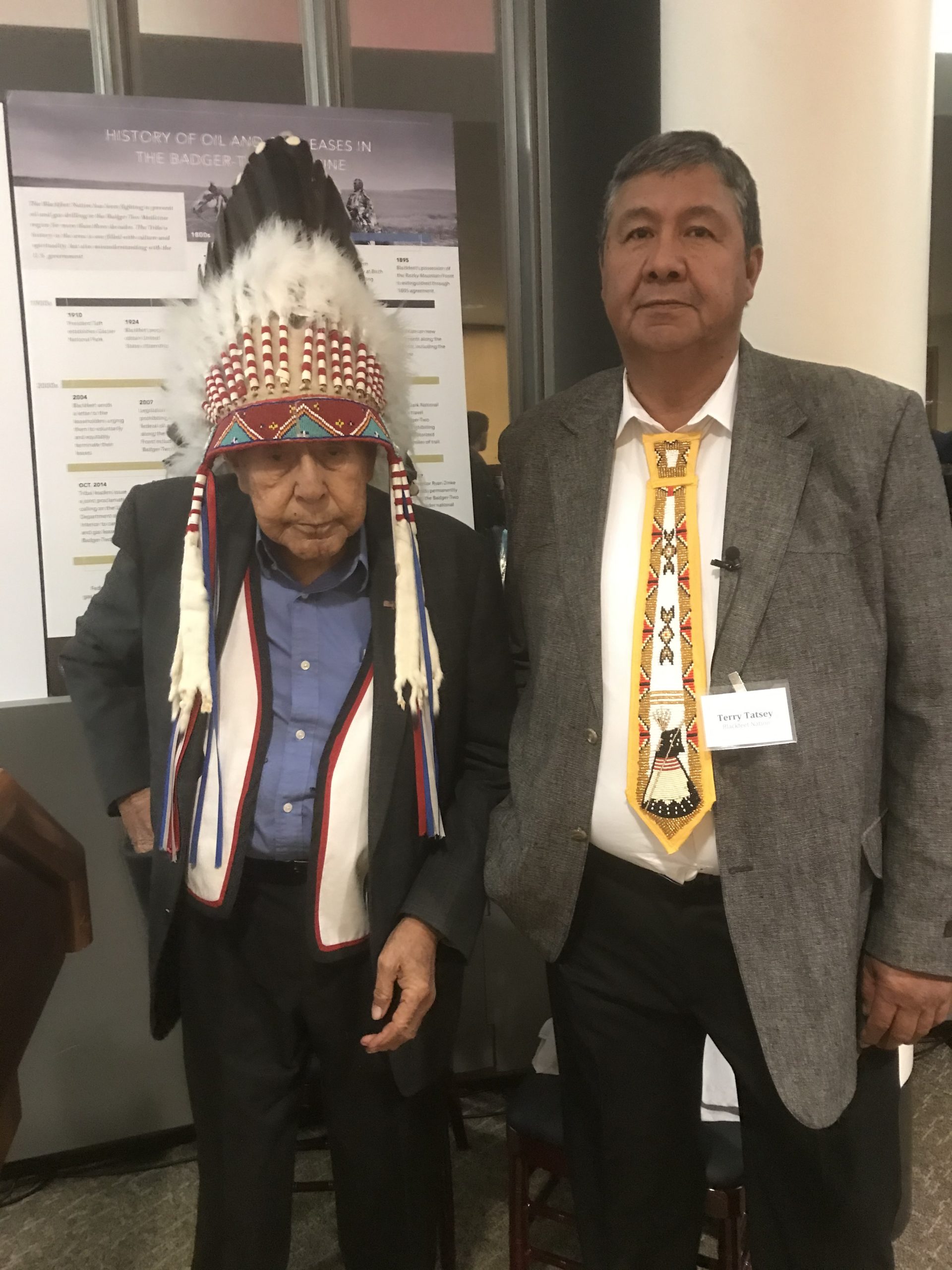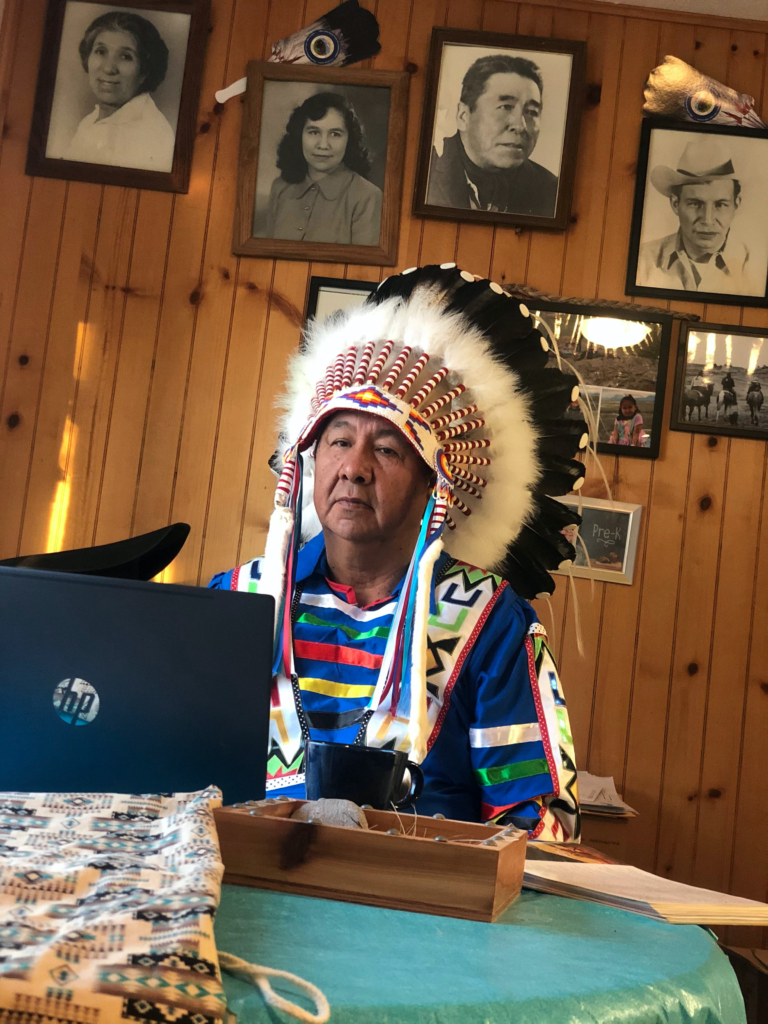Here at the Center, we wish to express our gratitude for the many contributions Indigenous people have made to sustaining biodiversity, reversing habitat fragmentation, and resisting environmental injustice.
In celebration of Native American Heritage Month, each Monday in November we will be sharing stories from four Indigenous conservation practitioners.
These conversations offer an opportunity to hear from Indigenous conservationists about their experiences, their path to working in conservation, and their visions for a future that honors Indigenous peoples and achieves collective conservation goals.
We hope you enjoy these stories.
In our fourth installment of our Native American Heritage Month Partner Spotlight series, we sat down with Terry Tatsey. In addition to his role as a Senior Advisor at the Center for Large Landscape Conservation, Terry has served many leadership roles within the Blackfeet Tribe and Blackfeet Community College.
Introduction
Terry Tatsey never sought a life of public service–he had long planned to work on his family’s ranch, but life had other plans. Terry was instrumental in building Blackfeet Community College’s environmental science program, before serving on the Blackfeet Tribal Business Council where he worked to integrate Amskapi Piikani values and knowledge into management decisions.
Terry now works in a variety of capacities–all of which relate to his vision of ensuring a healthy connected landscape that protects and sustains the integrity of Blackfeet homelands for generations to come.
When Life Has Other Plans
Terry Tatsey grew up on the Blackfeet Reservation where he spent a great deal of time learning from his grandparents, who passed on many lessons. At age 10 he lived with his paternal grandparents who taught him about gathering, hunting, and Amskapi Piikani ways of life.
After his paternal grandfather passed, he moved in with his maternal grandfather who continued to teach him the ways of the Blackfeet People. During his collegiate studies, Terry focused on ranch management and agribusiness at Montana State University and spent some time at Haskell Indian Nations University, before finding his way back home with plans to work on his family ranch.
Life however, had other plans for Terry. At home on the ranch one evening a phone call came in asking him to help Blackfeet Community College start an associate science degree program at the college. They needed someone to build out curriculum and develop the program from the ground up. Terry exhausted every option, offering up names and suggestions for someone to fill this role, but they were insistent. He started first thing the following morning.
Terry reflects on that decision explaining that:
“Things happen in life that you don’t plan, and when life has other intentions that’s the path you are supposed to take.”
In his new role, Terry was able to lean heavily on the teachings of his elders and integrated Blackfeet traditional values and practices into the new program he developed.
He saw a need to move away from the emphasis on forestry (approximated 10% of the Blackfeet Reservation is forested) and adopt a broader approach that represented the full spectrum of natural processes and systems represented on Blackfeet Homelands. Terry envisioned a program that cut across natural resource areas like fish and wildlife, lands, and forestry and included both the old knowledge of the Blackfeet people alongside western science in order to fulfill the accreditation needs of the college.
When asked if there was a book that encompassed this approach and could be assigned to the class, Terry replied simply that a book like that had never been written. To fill this void, Terry reached out to Elders and within six months had assembled an advisory team of Elders who developed curriculum for the program.
Under Terry’s guidance, Blackfeet Community College began offering an associate science degree program in the fall of 1994, featuring coursework by conservation practitioners, natural resource experts, western science experts, and Elders. Field days helped to connect classroom concepts directly to the knowledge they were seeking, enabling students to fully engage with the curriculum in meaningful ways.
Reflecting on this moment Terry says, “I became a student all over again, along with everyone in the class, we had grandparents, teenagers, and all other types of students enrolled.” The variety of students in the class enriched the experience for everyone. Grandparents brought deep knowledge gained from decades of working and living on the land, and youthful 18- and 19-year old students brought tech savviness that elevated the learning environment for everyone. Word about the program’s success spread and by the late 1990’s it was one of the highest enrolled degree programs.
A Call to Serve (Again)
A few short years later, Terry moved into a more administrative role at the college where he quickly experienced frustrations with politics and how politics overlooked on-the-ground issues. Terry had never planned to work in politics and never had political ambitions, but once again found felt that teachings of his Elders carried a responsibility greater than his own plans. Terry ran and won a seat on the Blackfeet Tribal Business Council where he worked to promote land planning for the Tribe and integrate Amskapi Piikani values into management decisions.
Reflecting on his time on the Tribal Council Terry emphasizes:
“[My] choices are driven by responsibility. As a parent and grandparent, I have a responsibility to do this. The transfer of knowledge brings responsibility.”

Q&A With Terry
Looking forward 5, 10, and 50 years, what is your vision for your work? What is the legacy you hope to leave?
True to his keen sense of humor, Terry begins with a quip that “I hope to be here in 5 years, in 50 years I won’t.”
Within five years Terry hopes that Blackfeet Nation will have a comprehensive land plan that considers everything that lives on the landscape, the plants, animals, and people as part of the whole living system. Terry envisions a future where the integrity of the landscape -as it was given to the Blackfeet- is preserved through responsible utilization.
As part of this, he works towards a future where people consider the impacts roads and structures have on nature:
“We as human beings are not above any other being, we are just a part of it. I hope that in the future, when we make decisions that impact plants and animals, that we make a good decision, that considerers everything within the system we live in.”
Further down the line, Terry hopes for a future where today’s younger generations are engaged in decisions taking place across the historic homelands of the Amskapi Piikani people. The aboriginal lands of the Blackfeet extend from present day Montana to southern Alberta. Terry hopes that 50 years from now, today’s grandchildren and their friends will be actively engaged in caring for their homelands and shaping the future of these treasured landscapes for generations to come.
In the course of your work you’ve partnered with both tribal and non-tribal partners. What advice do you have for outside partners who would like to work with the Blackfeet Nation?
Terry advises that conservation organization evaluate what they are trying to accomplish and see if there is alignment with tribal priorities. In situations where there are common goals, tribes must take the lead, but also need support whether that be technical, legal, or financial. If the goals of the organization overlap with tribal interests, there is opportunity for collaboration, but outside organizations must be willing to advise when they can and listen when they need to.
November marks Native American Heritage Month, is there anywhere you’d like to direct readers to so they can learn more about the Amskapi Piikani peoples?
Terry encourages readers to learn about the Blackfeet peoples and their histories. The Blackfoot Confederacy includes the Piegan Blackfeet, Siksika, Kainai or Blood Tribe of southern Canada and the Piikani Nation in northern Montana. Terry cautions folks to remember that while books are fine options for learning, the best approach is to spend time with the Blackfeet people themselves. Terry’s last words of advice in case you visit are:
“Be prepared for no fast answers, something that you think can be answered in five minutes might end up taking five days.”



